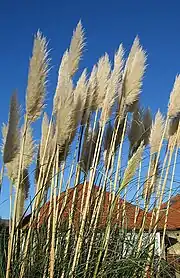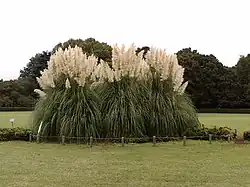| Pampas grass | |
|---|---|
 | |
| Inflorescences | |
| Scientific classification | |
| Kingdom: | Plantae |
| Clade: | Tracheophytes |
| Clade: | Angiosperms |
| Clade: | Monocots |
| Clade: | Commelinids |
| Order: | Poales |
| Family: | Poaceae |
| Genus: | Cortaderia |
| Species: | C. selloana |
| Binomial name | |
| Cortaderia selloana | |
| Synonyms[1] | |
|
Arundo kila Spreng. ex Steud. | |
Cortaderia selloana is a species of flowering plant in the Poaceae family.[1] It is referred to by the common name pampas grass,[2] and is native to southern South America, including the Pampas region after which it is named.
Etymology
Cortaderia is derived from the Argentine Spanish name 'cortadera', meaning 'cutter', in reference to its razor sharp leaf margins.[3]
Selloana is named for Friedrich Sellow (1789–1831), a German botanist[3] and naturalist from Potsdam who worked as a plant collector in Brazil.[3] He studied the flora of South America, especially that of Brazil. The specific epithet selloana was given by Josef August and Julius Hermann Schultes in 1827.

Cultivars

Several cultivars are available, of which the following have gained the Royal Horticultural Society's Award of Garden Merit:
Population biology
Okada et al., 2007 find C. selloana populations are best distinguished by a Bayesian analysis of genetic features such as microsatellites.[11] Algorithms such as STRUCTURE are suitable for this.[11]
Negative impact
Cortaderia has become invasive in mild-winter areas of North America, especially the southern United States. It has also been banned in Hawaii and New Zealand because of its ability to outgrow and displace native plants. In Europe, it was first introduced in the United Kingdom, later spreading to other countries in the continent like Ireland, Portugal, Spain, France, and Italy. It is a common urban invader.[12]
Pampas grass is fast-growing and can form large masses along the roads, cliffs, riverbanks, and open areas that have been disturbed by human activities or natural disturbances. Pampas grass can displace native plants and destroy their habitats, reducing biodiversity.
The plant also competes with other native plants by monopolizing resources like shade, sunlight, and ground nutrients. Because of the large surface area, the leaves pose a significant fire hazard if placed near flammable substances.[13]
C. selloana often spreads from landscaping plantings.[11] Okada et al., 2007 find this is the source of the California population.[11]
Control methods
Pampas grass can be controlled through herbicide treatment. To accomplish this, the grass is cut down near the base. Next, a 2% glyphosate chemical solution is combined with a silicone-based surfactant and applied to enhance the penetration potential. This method works best in the fall because there is overall better control compared to other seasons. Another control method is to cut and bag inflorescences to prevent seeds from spreading or pulling seedlings.[14]
Soil disturbance that creates bare ground can promote invasion, so it is essential to minimize disturbance or provide competition to seedlings. In order to control disturbance, applying mulch to exposed bare ground to smother seeds and prevent germination can be done. Also, planting or seeding desirable, non-invasive plants can provide competition to reduce germination and seedling establishment.[14]
C. selloana is considered a promising target for bioherbicide development.[15]
In culture
Author Li Hengrui (李恒瑞), whose work Kite Capriccio (風箏暢想曲) describes life as a child in 1950s Fengtai County, Anhui mentions the use of the long stem of the Puwei (蒲葦, Chinese for Cortaderia selloana) in the construction of kites.[16]
Several media outlets reported in the 2010s that it was planted by some couples who practise swinging in the United Kingdom as a way to indicate to other swingers that they enjoy that lifestyle.[17][18]
The reports caused a plunge in already declining sales, but the odd association has been dismissed by enthusiasts of the plant and gardening experts as "silly".[19][20]
Diseases
O'Donnell et al., 2004 first isolated Fusarium cortaderiae from this species.[21] F. cortaderiae is the cause of Fusarium head blight (FHB) of C. selloana.[21]
Gallery

 Jindai Botanical Garden, autumn 1964
Jindai Botanical Garden, autumn 1964

 Flower detail
Flower detail In California
In California Shrub
Shrub
References
- 1 2 "Cortaderia selloana (Schult. & Schult.f.) Asch. & Graebn". Plants of the World Online. The Trustees of the Royal Botanic Gardens, Kew. n.d. Retrieved September 27, 2020.
- ↑ BSBI List 2007 (xls). Botanical Society of Britain and Ireland. Archived from the original (xls) on 2015-06-26. Retrieved 2014-10-17.
- 1 2 3 Gledhill, David (2008). "The Names of Plants". Cambridge University Press. ISBN 9780521866453 (hardback), ISBN 9780521685535 (paperback). pp 122, 348
- ↑ "Cortaderia selloana 'Aureolinata'". RHS Plant Selector. Retrieved 15 April 2020.
- ↑ "Cortaderia selloana 'Evita'". RHS. Retrieved 12 April 2020.
- ↑ "Cortaderia selloana 'Monstrosa' | pampas grass 'Monstrosa'/RHS Gardening". RHS. Retrieved 12 April 2020.
- ↑ "Cortaderia selloana 'Patagonia'". RHS. Retrieved 12 April 2020.
- ↑ "Cortaderia selloana 'Pumila'". RHS Plant Selector. Retrieved 15 April 2020.
- ↑ "Cortaderia selloana Silver Feather='Notcort'". RHS. Retrieved 12 April 2020.
- ↑ "Cortaderia selloana 'Sunningdale Silver'". RHS Plant Selector. Retrieved 15 April 2020.
- 1 2 3 4 Ward, Sarah M.; Jasieniuk, Marie (2017). "Review: Sampling Weedy and Invasive Plant Populations for Genetic Diversity Analysis". 17 (6): 593–602. doi:10.1614/WS-09-082.1.
{{cite journal}}: Cite journal requires|journal=(help) - ↑ Nilon, Charles H.; Aronson, Myla F.J. (2023). Patterns, processes, consequences, and management. p. 199. ISBN 9781000963984.
- ↑ Robacker, Carol (1995). "Long-term shoot regeneration from pampas grass (Cortaderia selloana Schult.) through manipulation of growth regulators in vitro". Plant Cell Reports. 14 (11): 689–93. doi:10.1007/BF00232648. PMID 24186623. S2CID 6664693.
- 1 2 "Pampas Grass Cortaderia selloana". WASHINGTON STATE Noxious Weed Control Board.
- ↑ Sheppard, AW; Shaw, RH; Sforza, R (2006). "Top 20 environmental weeds for classical biological control in Europe: a review of opportunities, regulations and other barriers to adoption". 42 (2). doi:10.1111/j.1365-3180.2006.00497.x.
{{cite journal}}: Cite journal requires|journal=(help) - ↑ Putonghua Shuiping Ceshi Gangyao. 2004. Beijing. pp.350-351. ISBN 7-100-03996-7
- ↑ Guardian Staff (May 31, 2017). "Pampas grass: the not-so secret symbol of swingers is a turn-off". The Guardian. Archived from the original on August 10, 2018. Retrieved August 10, 2018 – via www.theguardian.com.
- ↑ Rudgard, Olivia (May 30, 2017). "Exclusive: Pampas grass sales are falling because it is a secret signal for swingers". The Telegraph. Archived from the original on October 17, 2019. Retrieved October 17, 2019 – via www.telegraph.co.uk.
- ↑ "People have stopped buying this garden plant because it's used to signal that homeowners are swingers". The Independent. 2017-05-31. Archived from the original on 2019-03-25. Retrieved 2019-03-25.
- ↑ Gallagher, Alanna. "Is pampas grass really a signal to swingers?". The Irish Times. Archived from the original on 2019-05-02. Retrieved 2019-03-25.
- 1 2 Valverde-Bogantes, Esteban; Bianchini, Andreia; Herr, Joshua R.; Rose, Devin J.; Wegulo, Stephen N.; Hallen-Adams, Heather E. (2020). "Recent population changes of Fusarium head blight pathogens: drivers and implications". Review and symposia articles/Articles de revue. 42 (3): 315–329.
{{cite journal}}: Cite journal requires|journal=(help)
External links
- Pampas grass
- Cortaderia selloana
- Blueplanetbiomes.org
- Pampas Grass under the microscope
- Pampas Grass
- Cortaderia selloana (pampas grass). 2009. doi:10.1079/cabicompendium.11872. S2CID 253606262.